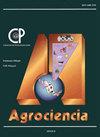三种绿色肥料对墨西哥坎佩切州本地玉米农艺性状的影响
IF 0.5
4区 农林科学
Q4 AGRICULTURE, MULTIDISCIPLINARY
引用次数: 0
摘要
在玉米(Zea mays L.)的农艺管理中,化学肥料可以代替施肥技术,减少过度使用商品肥料的污染效应。假设接种或不接种微生物的豆科绿肥能够促进X 'mejen Naal玉米的农艺性状,与常规施肥相当。为了测量对X´mejen Naal玉米农艺性状的影响,设计了一个完全随机分组的双因子试验,重复4次,在接种或不接种Fosfonat的3种绿色肥料(内生菌根,EM,加固氮细菌,NFB)中进行试验。处理方法为:粘虫(Mucuna pruriens, T1=MUC)、Xpelón (Vigna unguiculata, T2=PEL)、赤眼蜂(Phaseolus lunatus, T3=IBE)、接种的粘虫(T4=MUCEM)、接种的Xpelón (T5=PELEM)、接种的赤眼蜂(T6= IBEEM)和添加200 kg ha-1的硫酸铵(T7=ARDAP)的对照。结果表明,绿肥种类及其与接种共生体的相互作用对X´mejen Naal玉米鲜重和生物量的影响只存在差异。IBE和ARDAP分别以鲜重(1162和1251 g)、干重(168.6和163.6 g)和7.3 Mg ha-1(兆克/公顷)在玉米植株的干空气生物量中表现突出。尽管各处理玉米产量相似,但IBE和ARDAP处理的平均产量也较高,分别为3.5和3.3 Mg ha-1。所有产量(饲料和谷物)都成功地表达了X´mejen Naal的潜力,这与建议在坎佩切州的Luvisol土壤中使用绿色肥料作为传统施肥的农业环境替代品有关。本文章由计算机程序翻译,如有差异,请以英文原文为准。
EFFECT OF THREE GREEN MANURES ON THE AGRONOMIC CHARACTERISTICS OF NATIVE X’MEJEN NAAL MAIZE IN CAMPECHE, MEXICO
In the agronomic management of maize (Zea mays L.), chemical fertilizers can be substituted for fertilizing techniques that reduce the pollutant effect of the excessive use of commercial fertilizers. The hypothesis was the green manure of legumes with or without the inoculation of microorganisms are capable of promoting agronomic characteristics of X’mejen Naal maize, comparable to conventional fertilization. In order to measure the effect in the agronomic characteristics of X´mejen Naal maize, an experiment was designed in complete randomized blocks in a bifactorial arrangement with four repetitions, in which three green manures were tested, with or without the inoculation of Fosfonat (endomycorrhizas, EM, plus nitrogen fixating bacteria, NFB). Treatments were Mucuna (Mucuna pruriens, T1=MUC), Xpelón (Vigna unguiculata, T2=PEL), Ibes (Phaseolus lunatus, T3=IBE), inoculated Mucuna (T4=MUCEM), inoculated Xpelón (T5=PELEM), inoculated Ibes (T6= IBEEM) and the control with the incorporated biomass of weeds plus the addition of 200 kg ha-1 of diammonium phosphate (T7=ARDAP). Results showed that there were only differences caused by the types of green manure and their interaction with the inoculated symbionts in the fresh weight or biomass in X´mejen Naal maize. IBE and ARDAP stood out in fresh weight (1162 and 1251 g), dry weight (168.6 and 163.6 g), 7.3 Mg ha-1 (Megagrams per hectare) in the dry aerial biomass in the maize plants, respectively. Despite the grain yield of maize was similar among treatments, it was noticeable that the higher average yields were also observed in IBE and ARDAP with 3.5 and 3.3 Mg ha-1 respectively. All yields (fodder and grain) managed to express the potential of the X´mejen Naal, which is relevant to recommend the use of green manures as an agro-environmental alternative to conventional fertilization in the Luvisol soils of Campeche.
求助全文
通过发布文献求助,成功后即可免费获取论文全文。
去求助
来源期刊

Agrociencia
农林科学-农业综合
CiteScore
0.50
自引率
33.30%
发文量
51
审稿时长
18-36 weeks
期刊介绍:
AGROCIENCIA is a scientific journal created and sponsored by the Colegio de Postgraduados. Its main objective is the publication and diffusion of agricultural, animal and forestry sciences research results from mexican and foreign scientists. All contributions are peer reviewed. Starting in the year 2000, AGROCIENCIA became a bimonthly and fully bilingual journal (Spanish and English versions in the same issue). Since 2007 appears every month and a half (eight issues per year). In addition to the printed issues, the full content is available in electronic format.
 求助内容:
求助内容: 应助结果提醒方式:
应助结果提醒方式:


